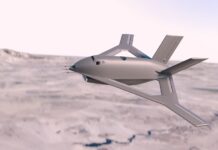The Air Force Research Laboratory (AFRL) is looking for means to reduce the acoustic signature of such UAVs. As part of this effort AFRL selected Aurora Flight Sciences to develop an innovative propeller design software code that combines existing acoustic, aerodynamic, and stress codes into a single executable unit. Such a system would have potential for designing SUAVs that are significantly harder to detect, along with improved aerodynamic performance, thereby providing much greater protection and safety for valuable SUAVs.
Small unmanned aerial vehicles are designed to fly at low altitude, delivering real-time intelligence flying over the enemy. Larger unmanned vehicles are flying at an altitude of 15,000 ft or higher. At these altitudes, their presence in the sky is noticed by the characteristic engine noise, but the specific area where they are ‘looking’ at is unknown to the enemy, as they cover a large area. Unlike these high flying UAVs, Small UAVs fly much lower, hence, when they are spotted, people on the ground immediately realize there are targeted and would take evasive action. Furthermore, their presence will draw considerable fire from the ground, which could compromise their mission.

The acoustics of propellers has long been a factor of their design in their most common aviation applications — general aviation and regional transport design — driven by both passenger comfort and community noise regulations. Only recently has there been significant interest in the acoustics of propellers for small UAVs. Typically, the propellers of such vehicles have been derived from model aircraft propellers and little work has been done on the optimization of their design with regards to acoustics or performance.
The Air Force Research Laboratory (AFRL) is looking for means to reduce the acoustic signature of such UAVs. As part of this effort AFRL selected Aurora Flight Sciences to develop an innovative propeller design software code that combines existing acoustic, aerodynamic, and stress codes into a single executable unit. Such a system would have potential for designing SUAVs that are significantly harder to detect, along with improved aerodynamic performance, thereby providing much greater protection and safety for valuable SUAVs.
The new code will be capable of adapting an open, ducted, or some other propeller geometry or performance variable until an optimum aero-acoustic design is achieved. According to the project’s principal investigator, Paul Dahlstrand, “Typically propeller design had been done sequentially, alternating back and forth between aerodynamic and acoustic codes until a solution was found, which was almost certainly not optimal. Our approach will provide the propeller designer with a truly aeroacoustic-optimized solution.” This technology will allow creation of a new technology-based tool to serve not only the US military market but also the commercial ultralight aircraft and radio-controlled aircraft markets as well.
Energy scavenging System Could Power Future Unmanned Systems
Aurora has also embarked on the development of an integrated energy scavenging and storage system, under a DARPA program. The new energy source could be used in portable electronics, unmanned vehicles, and weapons systems.
Aurora’s effort will develop and evaluate an integrated system that includes both solar cells for day time use and infrared photovoltaic cells for night time use, as well as integrating these energy sources with thin-film lithium batteries.
The majority of wireless devices are powered by batteries, which must be replaced or recharged when depleted; this is a major limitation for remotely located systems. Solar energy scavenging is widely used for recharging, but alternative technologies are required to provide night time scavenging capability to extend system lifetime and utility. Aurora’s concept will target infrared (IR), or thermal radiation, as a nocturnal energy source.
“Thin-film micro-batteries have remarkable performance and life compared to everyday batteries,” said Dr. Philip Johnson, the program’s principal investigator. “When embedded with ambient energy scavenging devices we have the prospect of batteries that will remain perpetually charged.”
A key attribute will be the development of the energy sources and batteries not just as individual technologies, but integrating them into a reliable night/day power system, including innovative ways to package the system into existing vehicle or weapons systems structures. Aurora believes that this integrated scavenging and storage system technology may provide extended lifetime and utility to other systems, such as unmanned aerial vehicles (UAVs), in the future.
The program is managed by the Defense Advanced Research Projects Agency (DARPA) Microsystems Technology Office (MTO).












